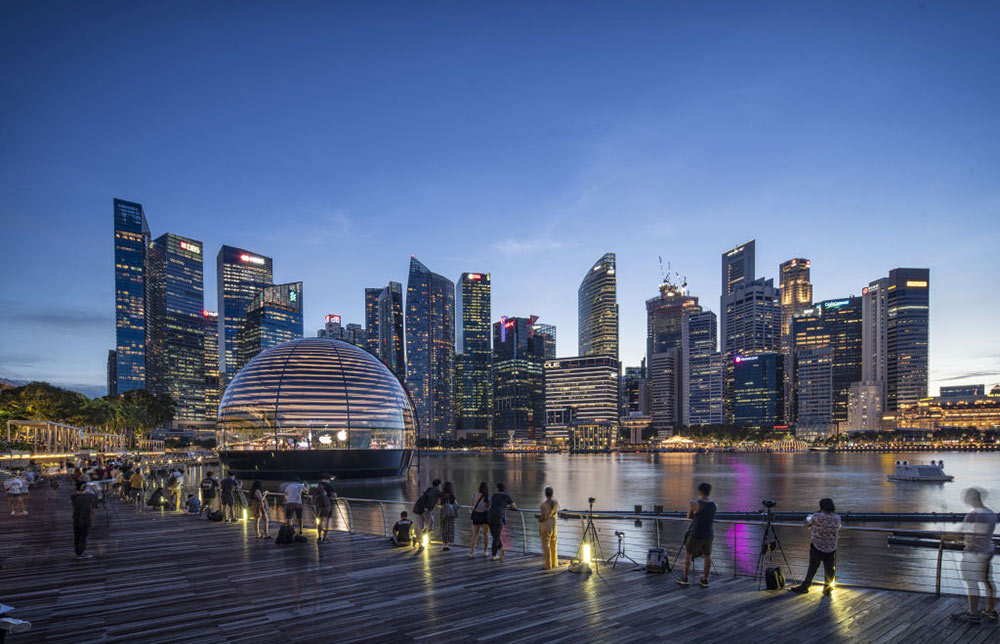新加坡和香港,两个相互竞争的金融中心,成为世界上首例相互开放“空中旅行泡泡”的地区。10月15日,两地政府宣布了一项初步协议,根据该协议,两地居民只要满足新冠核酸检测呈阴性的条件,就能够前往另一个城市旅行,不用隔离。
香港商务及经济发展局局长邱腾华说:“经历了旷日持久的抗击疫情战斗,这是我们的城市正逐步回到常态的一个里程碑。”有关安排的具体细节仍然在讨论中,但邱腾华认为,他们“完全有信心”,该计划将“很快实现”。
但是之前,其他类似于“旅行泡泡”的努力,并没有持续太久。

早在今年5月,澳大利亚和新西兰政府就已经开始考虑开放两地“旅行泡泡”。但现在,事实证明,这个概念过于乐观了——当地病例数量突然激增,计划被迫暂停。
目前最理想的情况是,各国实施了隔离豁免,但这种豁免往往“有来无回”。例如,10月16日,澳大利亚在宣布接纳新西兰乘客,无需隔离,相反,新西兰仍然要求到访该国的所有游客接受为期两周的隔离。
新西兰已经将新冠肺炎疫情基本控制在可控范围内,自5月以来,该国每日新增病例大多为个位数。
与之对应,香港和新加坡摆脱疫情困境的时间并不长。
但是,新加坡交通部部长王乙康表示,香港和新加坡的新冠肺炎病例“发病率很低”,并且有“强有力的机制”来控制疫情。他说:“这给了我们相互、逐步开放边界的信心。”

10月15日,新加坡报告了3起新冠病毒病例,实现了连续四天仅个位数增长。同天,香港报告了12起病例,为一周内单日最高增幅。尽管这一数字与许多其他地区相比较低,但香港保持高度警惕,12起“激增”同样令港人担忧。
两周前,香港卫生署署长陈汉仪提出了强制执行核酸检测的想法——一些专家警告说,在单日新增18例病例之后,可能会出现“第四波”疫情。
上个月,香港对近200万人进行了检测,以应对第三波疫情。专家们将第三波疫情归咎于香港之前的隔离豁免政策,该政策豁免了某些群体(如海空机组人员)的14天隔离期。
香港大学流行病学家高本恩认为,鉴于新加坡的低病例数,来自新加坡的游客对香港造成的风险非常小。但他表示,对于来自两地的旅客,在出发前或抵达后安排检测仍然很重要。

目前来看,“旅行泡泡”或将缓解两地航空公司和旅游业的财务压力。消息公布后的10月15日,香港旗舰航空公司国泰航空的股价收盘上涨6%,创下七周来最大涨幅。
据了解,在世界上最繁忙的航线中,“新加坡-香港”排在第17位。去年,香港游客占到新加坡游客总数的3%。当然,今年两地的游客流动几乎停止。赴港的新加坡游客在2020年前8个月锐减超93%。
根据“旅行泡泡”的初步协议,旅客必须在香港和新加坡政府认可的机构接受核酸检测。航空公司也必须遵循专门的航线,不允许转机,也不允许团队游。
香港政府于上个月表示,希望与新西兰、越南、韩国、德国和法国等其他10个国家一起开启“旅行泡泡”计划。
但由于香港仍然在实施社交隔离措施,四人用餐依旧不被允许,公共海滩及公开活动受限,许多旅游活动在游客抵达后将被禁止。(财富中文网)
编译:杨二一
新加坡和香港,两个相互竞争的金融中心,成为世界上首例相互开放“空中旅行泡泡”的地区。10月15日,两地政府宣布了一项初步协议,根据该协议,两地居民只要满足新冠核酸检测呈阴性的条件,就能够前往另一个城市旅行,不用隔离。
香港商务及经济发展局局长邱腾华说:“经历了旷日持久的抗击疫情战斗,这是我们的城市正逐步回到常态的一个里程碑。”有关安排的具体细节仍然在讨论中,但邱腾华认为,他们“完全有信心”,该计划将“很快实现”。
但是之前,其他类似于“旅行泡泡”的努力,并没有持续太久。
早在今年5月,澳大利亚和新西兰政府就已经开始考虑开放两地“旅行泡泡”。但现在,事实证明,这个概念过于乐观了——当地病例数量突然激增,计划被迫暂停。
目前最理想的情况是,各国实施了隔离豁免,但这种豁免往往“有来无回”。例如,10月16日,澳大利亚在宣布接纳新西兰乘客,无需隔离,相反,新西兰仍然要求到访该国的所有游客接受为期两周的隔离。
新西兰已经将新冠肺炎疫情基本控制在可控范围内,自5月以来,该国每日新增病例大多为个位数。
与之对应,香港和新加坡摆脱疫情困境的时间并不长。
但是,新加坡交通部部长王乙康表示,香港和新加坡的新冠肺炎病例“发病率很低”,并且有“强有力的机制”来控制疫情。他说:“这给了我们相互、逐步开放边界的信心。”
10月15日,新加坡报告了3起新冠病毒病例,实现了连续四天仅个位数增长。同天,香港报告了12起病例,为一周内单日最高增幅。尽管这一数字与许多其他地区相比较低,但香港保持高度警惕,12起“激增”同样令港人担忧。
两周前,香港卫生署署长陈汉仪提出了强制执行核酸检测的想法——一些专家警告说,在单日新增18例病例之后,可能会出现“第四波”疫情。
上个月,香港对近200万人进行了检测,以应对第三波疫情。专家们将第三波疫情归咎于香港之前的隔离豁免政策,该政策豁免了某些群体(如海空机组人员)的14天隔离期。
香港大学流行病学家高本恩认为,鉴于新加坡的低病例数,来自新加坡的游客对香港造成的风险非常小。但他表示,对于来自两地的旅客,在出发前或抵达后安排检测仍然很重要。
目前来看,“旅行泡泡”或将缓解两地航空公司和旅游业的财务压力。消息公布后的10月15日,香港旗舰航空公司国泰航空的股价收盘上涨6%,创下七周来最大涨幅。
据了解,在世界上最繁忙的航线中,“新加坡-香港”排在第17位。去年,香港游客占到新加坡游客总数的3%。当然,今年两地的游客流动几乎停止。赴港的新加坡游客在2020年前8个月锐减超93%。
根据“旅行泡泡”的初步协议,旅客必须在香港和新加坡政府认可的机构接受核酸检测。航空公司也必须遵循专门的航线,不允许转机,也不允许团队游。
香港政府于上个月表示,希望与新西兰、越南、韩国、德国和法国等其他10个国家一起开启“旅行泡泡”计划。
但由于香港仍然在实施社交隔离措施,四人用餐依旧不被允许,公共海滩及公开活动受限,许多旅游活动在游客抵达后将被禁止。(财富中文网)
编译:杨二一
Rival financial hubs Hong Kong and Singapore are set to become the first regions in the world to open a reciprocal “air travel bubble,” after ministers from both governments announced a preliminary agreement on October 15. Under the deal, residents from either city would be able to travel to the other without undergoing quarantine—so long as they test negative for COVID-19.
“This is a milestone in our efforts to resume normalcy while fighting against the long-drawn battle of COVID-19,” Hong Kong Secretary for Commerce and Economic Development Edward Yau said. Full details of the arrangement are still being hashed out, but Yau has “every confidence” the plan can “come to fruition very soon.”
Previous "travel bubble" hopes have not lasted long.
Governments have floated the notion of opening travel bubbles since at least May—when Australia and New Zealand were mulling the idea. But the concept has so far proven too optimistic as sudden spikes in local case numbers put travel plans on hold.
At best, countries have implemented unrequited quarantine exemptions. On October 16, for example, Australia welcomed passengers from New Zealand without quarantine, but New Zealand still requires all tourists to undergo a two-week isolation.
The Kiwi nation has kept COVID-19 largely under control, with daily case numbers mostly in single digits since May.
Hong Kong and Singapore haven’t been out of the woods quite so long.
But Singapore Transport Minister Ong Ye Kung says that both Hong Kong and Singapore have “low incidence” of COVID-19 cases and have “robust mechanisms” to manage outbreaks. “This has given us the confidence to mutually and progressively open our borders to each other,” Ong said.
On October 15, Singapore reported three new coronavirus cases, completing four days of single digit growth. The same day, Hong Kong reported 12 COVID-19 cases—the highest single day rise in a week. Although those numbers are low compared to many other places, Hong Kong’s hyper vigilance makes even a spike of 12 cases cause for concern.
Just last week, Secretary for Health Sophia Chan floated the idea of enforcing mandatory COVID-19 tests as some experts warned of a possible “fourth wave” of infections following a daily increase of 18 cases.
Last month the city tested close to 2 million people to counter its third wave, which experts blamed on Hong Kong’s previous quarantine exemptions. Those exemptions waived the 14-day isolation period for certain groups, such as sea and air crew members.
“I think the risk posed to Hong Kong by travelers from Singapore would be minimal,” says Hong Kong University epidemiologist Ben Cowling, citing the city’s low case numbers. “But it would still be important to arrange testing for travelers from Hong Kong or Singapore either shortly before departure, or to arrange testing on arrival.”
The travel bubble could ease financial strain on airlines and the tourism industries of both cities. Shares in Hong Kong's flag carrier Cathay Pacific closed up 6% on the news on October 15 after making its biggest gains in seven weeks.
The route between Hong Kong and Singapore is normally the 17th busiest in the world, with Hong Kong tourists accounting for 3% of all visitors to Singapore last year. This year, of course, that flow came to a near halt. In Hong Kong, visits from Singapore dropped over 93% in the first eight months of 2020.
Under the preliminary agreement, travelers will be required to obtain a negative COVID-19 test from a facility recognized by both Hong Kong and Singapore governments. Airlines will also have to run dedicated routes—not allowing for transit passengers—and group tours will not be allowed.
Hong Kong’s government last month said it hoped to open travel bubbles with ten other countries, including New Zealand, Vietnam, South Korea, Germany and France.
But with social distancing measures still enforced in Hong Kong—limiting dining groups to four people, closing public beaches and cancelling public events—many of the usual tourist activities will be off-limits when travelers arrive.






